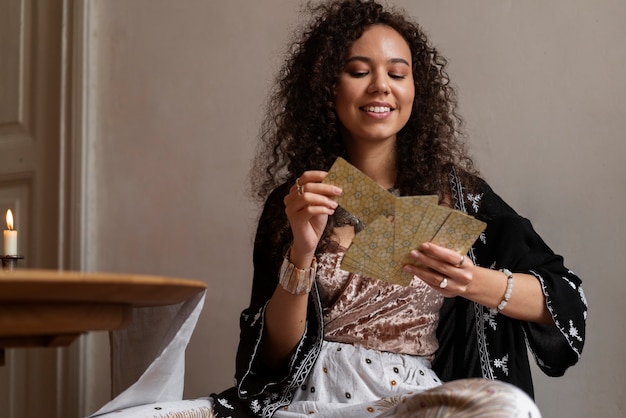
Welcome to the ultimate guide to tarot reading. This guide is here to help you navigate the world of tarot, whether you’re just curious, learning about its history, exploring different decks, or aiming to become an expert reader.
No matter where you are on your tarot journey, you’ll find info on choosing the right spreads, preparing your cards for accurate readings, and interpreting tarot cards for yourself and others. Dive into the magical and intriguing world of tarot cards!
Tarot cards began as an Italian four-suited card game in 14th-century Europe. Notable decks like the “Visconti-Sforza” and the “Mantegna” deck grew in popularity in the 15th century. By the 16th century, tarot became linked with mysticism. British astronomer John Dee even used them to converse with angels, connecting them to symbolic imagery.
In the 18th century, French occultist Antoine Court de Gébelin believed that the 22 Major Arcana cards were rooted in ancient Egyptian wisdom. Later, 19th-century researchers like Eliphas Levi connected tarot with the Hebrew Enochian alphabet.
Today, tarot has evolved from a simple fortune-telling tool to a powerful means for gaining insight and spiritual understanding. A standard tarot deck has 78 cards, split into the Major Arcana and Minor Arcana. The 22 Major Arcana cards depict universal themes, while the 56 Minor Arcana cards are divided into four suits—wands, cups, swords, and pentacles—each representing different elements and facets of life.
Each suit in the Minor Arcana includes fourteen cards: Ace through ten plus four court cards: Page, Knight, Queen, and King. For instance, cups represent emotions and relationships; wands signify creativity and action; swords deal with complex tasks; and pentacles focus on career and finances.
Popular tarot decks include:
– The Rider-Waite deck, noted for its detailed imagery.
– The Thoth Tarot by Aleister Crowley and Lady Frieda Harris, known for its esoteric design.
– The modern Wild Unknown Tarot by Kim Krans, featuring minimalist, hand-drawn artwork.
– Shadowscapes Tarot by Stephanie Pui-Mun Law, blending symbolism and storytelling.
– Gendron Tarot, known for its vibrant and striking visuals.
– Black and White Tarot by Victor P., celebrated for its monochromatic designs.
– Tarot of Dreams by Ciro Marchetti, which combines intricate digital artwork with traditional symbolism.
Various tarot readings include:
– General readings that provide insights into life circumstances.
– Question-based readings that address specific issues or decisions.
– Theme-based readings focused on particular aspects of life, such as love or career.
– Past or future readings that examine how past events influence the present or predict future scenarios.
– Yes-or-no readings for straightforward answers.
– One-card readings for quick, focused insights.
Getting the most out of tarot:
– Choose a deck that resonates with you.
– Understand the meanings of each card and practice interpreting them.
– Set a clear goal for your reading.
– Shuffle the deck with intention, choose a suitable spread, and interpret the cards based on both traditional meanings and your intuition.
– Reflect on the reading and how it pertains to your life.
When reading for others, establish clear boundaries and a comfortable environment. Explain the reading process, pay attention to your client’s needs, and offer empathetic yet honest interpretations. Explore different spreads based on your needs, such as the simple one-card spread, the detailed Celtic Cross, or the thematic Pentagram Spread.
Preparation for a tarot reading involves choosing the right type of reading, researching and choosing a tarot expert, and setting up a quiet space. Clear your mind to make the experience more fruitful, take notes during the reading, and reflect on the insights gained.
Connecting with your cards is essential. You can purify your deck by spreading the cards and blowing over them or using crystals to cleanse them. Engage in meditation to align your energy with the cards. Personalize your deck to deepen your connection.
For an accurate reading, focus on the traditional meanings of the cards and how they relate to your current situation. Let your intuition guide you to uncover deeper insights.
Online tarot readings provide a convenient way to connect with experienced readers from anywhere in the world. Different types of tarot readings and spreads require various numbers of cards, depending on the complexity of the inquiry.
Finally, you can perform a free tarot reading for yourself. Just be impartial and open to ensure an accurate interpretation. Many online platforms offer comprehensive profiles and reviews to help you choose the best tarot reader for you.
Take your time to understand the cards and their meanings, practice consistently, and trust your intuition to excel in the world of tarot reading.


